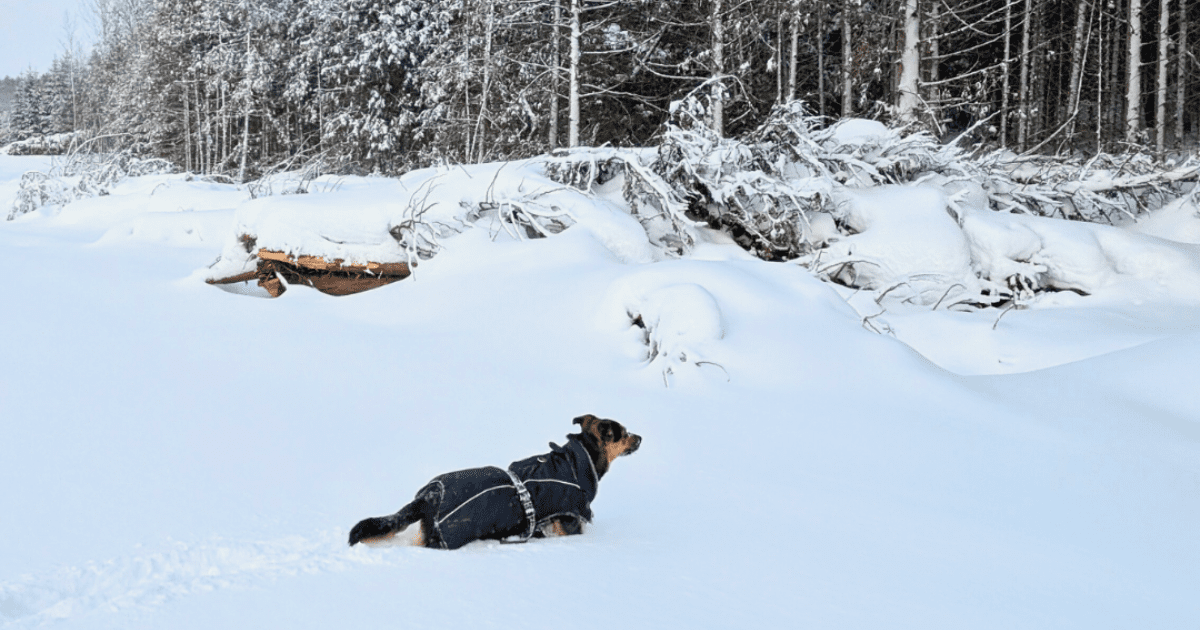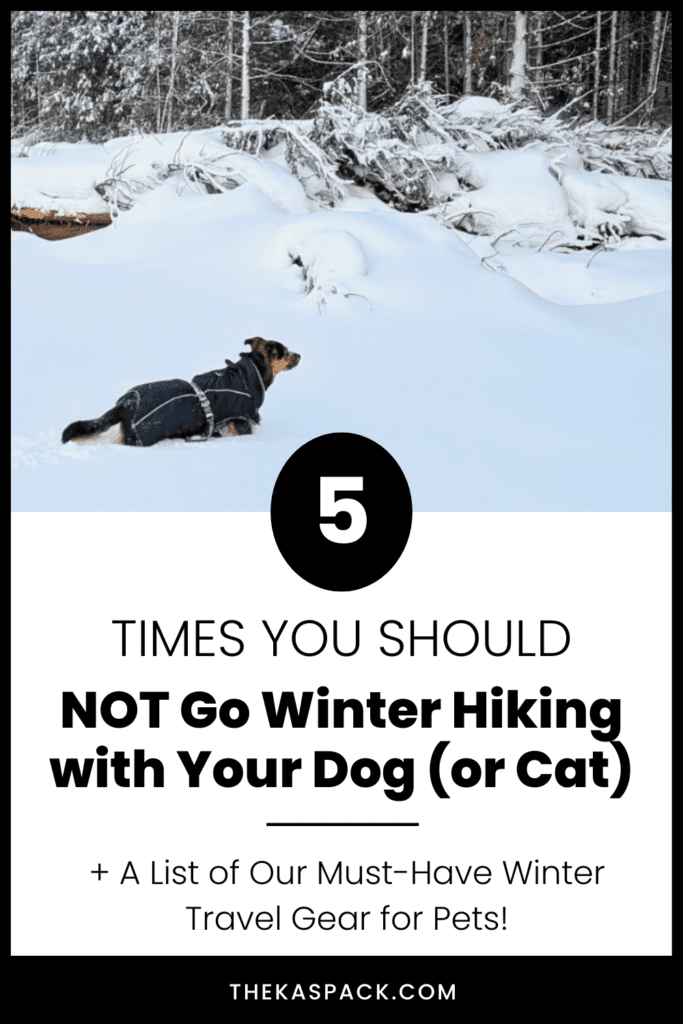5 Times You Should NOT Go Winter Hiking with Your Dog (or Cat)
Obviously, here at The Kas Pack, we’re all about finding ways to include your pets in your outdoor travels. That includes exploring the Winter Wonderland Ontario transforms into at this time of year.
We love hitting the trails with our dogs and even our cats (yes, really!).
Winter hiking introduces some unique challenges, and it’s not for everyone. While the right gear can help extend your pet’s adventure season, sometimes the best (and safest) decision is to leave them cozy at home.

This post contains affiliate links, which means if you click and buy, we will make a commission (at no cost to you). See our full disclosure policy for more details.
Here Are 5 Times When Bringing Your Pet Hiking May Not Be a Good Idea…
During Extreme Cold Spells
Yes, coats and boots can help keep your pet warm. However, we have all experienced those bitter cold spells when even our winter gear leaves us shivering.
The same is true for our pets.
Pay close attention to the temperature when planning your hikes, including the wind chill. If it’s too cold for people to be out for too long without risk of hypothermia, it’s too cold for your furry friends.
This “safe” threshold will also vary depending on your individual pet.
Their cold tolerance will depend on their age, breed, coat type, health conditions, and, of course, personal preferences.
Our dogs both LOVE the snow and enjoy playing in it. However, as much as Lucifer thinks it’s fun, the cold temperatures don’t always love him.
Meanwhile, our Anatolian Shepherd, Willow, will happily take a nap in the middle of a snowbank as if she’s basking on a sunny beach.
Knowing this helps us decide how long they can stay outside in the winter or if it’s best to keep the pets indoors.
When a Storm is Rolling In
Are there warnings about heavy snowfall or gale-force winds in the forecast? In these conditions, it’s best not to tempt fate.
Even if a snowstorm is expected to move through just to the south of your chosen trail, there’s always the possibility that it will change course slightly, catching you off-guard.
Most outdoor adventure experts suggest avoiding hitting the trails during extreme storms, even for the most experienced travellers, and the same applies to our pets.
Instead, I recommend rescheduling that hike for a few days later when you can enjoy the beauty of the freshly fallen snow.
(Lucifer would also like to point out the fun of bounding through untouched snowbanks)

When You or Your Pet Are Feeling “Off”
Hiking in the winter is a great workout. Trying to move through the snow will challenge you to use more muscles than you would on a sunny summer day.
This also means you will feel it even more if you’re sick or recovering from an illness.
If you or your pet has been feeling ill, stay home and give yourself time to recover. Not only is it safer, but the rest will also help you recover faster.
Don’t forget: your pet is counting on your ability to keep them safe. You need to be feeling up to the challenge, too!
When you are feeling up to adventuring again, start small. Begin with short, easy hikes and work your way back up.
If the Trail Conditions Are Too Questionable
Hiking on an icy trail isn’t impossible, but it does usually require some special gear to make sure that you aren’t going to slip and hurt yourself.
People usually gear up with microspikes or crampons to give themselves some added traction.
While our dogs are generally better on slippery surfaces than we are, there are times that an icy trail is nothing more than a recipe for an injury.
Check trail conditions before heading out, especially after a recent flash freeze.
I recommend using apps like AllTrails to check trail conditions and recent reviews to better understand what you may be facing.
Hikes Starting Late in the Day
The days are shorter during the winter months, limiting the time you have each day to hike in the daylight.
Some hikers will push their boundaries, testing the limits on how late they can get out. But hiking in the dark with your dog or cat will also introduce more risks and dangers for them.
Without daylight, it’s hard (almost impossible) to supervise them properly.
Even if you are keeping your pet on a leash or in a backpack during your hike, the temperatures are dropping, wildlife is coming out, and they are also potentially at risk if you lose your footing in the dark.
When hiking with your dog or cat, start early or plan for shorter treks to ensure you can get back to the trailhead before the sun goes down.
Otherwise, it’s best to leave them at home.

Must-Have Winter Hiking Gear for Dogs and Cats
As I mentioned above, the best thing you can do when adventuring during the colder months is to gear up appropriately.
Whether you’re new to exploring during this season or looking to add to your gear collection, I’ve got you covered.
Here is our go-to list of must-have cat and dog winter hiking gear:
Coats and/or Sweaters
One of the most obvious pieces of outdoor gear is a sweater and/or coat to keep your pet warm.
This, of course, depends on how cold it is and your pet’s tolerance level.
Our dogs both love being outdoors in the winter, but Lucifer is much more sensitive to the cold. So, while Willow rarely wears anything, Lucifer almost always wears a coat or sweater in the winter.
Don’t forget your cats!
Jinx isn’t a fan of the winter, but Pippen enjoys it. However, if she will be outside for more than a couple of minutes, she will have a sweater on.
Our go-to coats/sweaters currently are the RC Pets Baseline Fleece and Lucifer’s Shedrow K9 Chinook Coat.
But we are exploring more options and will share them here on the blog as we do!
**NOTE: The promo code applies to regular-priced items only and cannot be used on discounted or clearance products (this includes the Walking Kit and the Good Dog Kit, which are already discounted or products that are temporarily offered at a lower price during our upcoming Winter Sale.)
The code cannot be stacked with other promotions, such as special discounts on orders over $100 or in conjunction with smaller discounts offered to new newsletter subscribers.
Paw Protection
The ice and snow can be hard on your pet’s paws. Not to mention the ice melters you may encounter on more urban trails or at the trailhead.
There are several options for paw protection, depending on your needs.
Try a paw wax for dogs who are largely comfortable with the cold temperatures and just need a little protection from the surfaces they are walking on.
For Willow and the cats (who hate boots), we use
However, if your pet also gets cold feet, you may want to consider using booties. Lucifer’s current go-to pair is from the brand QUMY on Amazon.
Don’t forget your own “paws.”
A good pair of hiking boots with merino wool socks will keep your feet warm. For traction, we always bring our Sportneer Crampons.
Eye Protection
This is a piece of gear we don’t currently use but are actively looking into after some conversations with fellow adventurers.
Pet goggles like Rex Specs (the brand at the top of our list) serve two purposes.
They will help protect your pet’s vision from snow blindness, a condition caused by the reflection of UV rays on the snow.
Plus, they add a layer of physical protection if you have a dog like Willow, who shoves her face in the snow when rolling around, not worrying about if there may be ice or other hazards.
Of course, they will require some conditioning at home before you hit the trails to make sure your pet is comfortable.
The good news is if you invest the time and money now, it’s gear that they can continue to use year-round when hiking, canoeing, kayaking, etc.
Added Warmth in Your Pet’s Backpack or Carrier
Are you hiking with a smaller pet or one with limited mobility, meaning they spend part of their outdoor time in a backpack or carrier?
If so, there are several ways you can make this space warmer and cozier for them.
We include the Furhaven Waterproof & Self-Warming Blanket in our cats’ backpacks to help raise the temperature slightly.
I’ve also heard of some cat and small dog parents using hand warmers like the ones from HotHands.

Nighttime Visibility
While I recommend not hiking at night with your pets (as mentioned in the list above), it’s always better to be prepared.
If something happens and your hike takes longer than anticipated, having a fallback for nighttime visibility will make it easier to keep your pet safe.
We use LED collars for our pets when we’re at home or at the campsite. But I love the Nite Ize SpotLit XL Rechargeable Collar Light when hiking.
It easily clips onto our bag or fits in a small pocket at the side, so we don’t have to worry about if we have it with us. But if the sun goes down, we can pull it out quickly and toss it on their collars.
The cats exclusively ride in their backpacks in that setting. But we still have a smaller version of the collar light to clip onto their harnesses as an added precaution.
Pet-Friendly First Aid Kit
The #1 thing you should have on hand for ANY outdoor adventure, regardless of the weather, is a fully stocked pet-friendly first aid kit.
You can purchase a premade kit online (adding anything to it you feel it might need after) or create your own.
To help, we’ve put together printable checklists for both hiking and camping first aid kits:
Plenty of Fresh Water
Your pet will actually need to drink more water during the colder months, making this point more important than ever!
There are many different forms of pet-friendly water bottles you can pack, depending on the style you prefer or how much space you have available in your hiking pack.
Our go-to is the Portable Dog Water Bottle from Lesotc, which clips on my pack, allowing for easy access on the trails.
Food and Snacks (aka Fuel)
Of course, you will need to fuel your pet for their outdoor travels, especially if you’re planning a longer or more challenging hike.
The best way to do this is to ensure you bring plenty of healthy options to feed your pet along the way.
Usually, my treat bag (or pockets) includes a mix of plain chicken breast pieces, dehydrated organ treats (like Vital Essentials Freeze-Dried Beef Liver), Lucifer’s favourite Charlee Bear Grain Free Crunch treats, and some other options.
This keeps it interesting for him, offers motivation when needed, and gives him the calories he needs to keep going.
I also carry lick treats, like these from Churu, for the cats, which offer both calories and hydration.
The goal is to find something your pet loves that also provides the nutrition they need along the way. Don’t be afraid to experiment with different options at home to see what they love most!
For the rest of our go-to basics (like leashes, harnesses, etc.), check out our full gear list HERE.

Do you have any must-have winter hiking items on your gear list that I missed? If so, I’d love to hear about them in the comments!
I’m always game to add to our gear collection (shh, don’t tell John… just kidding!)
